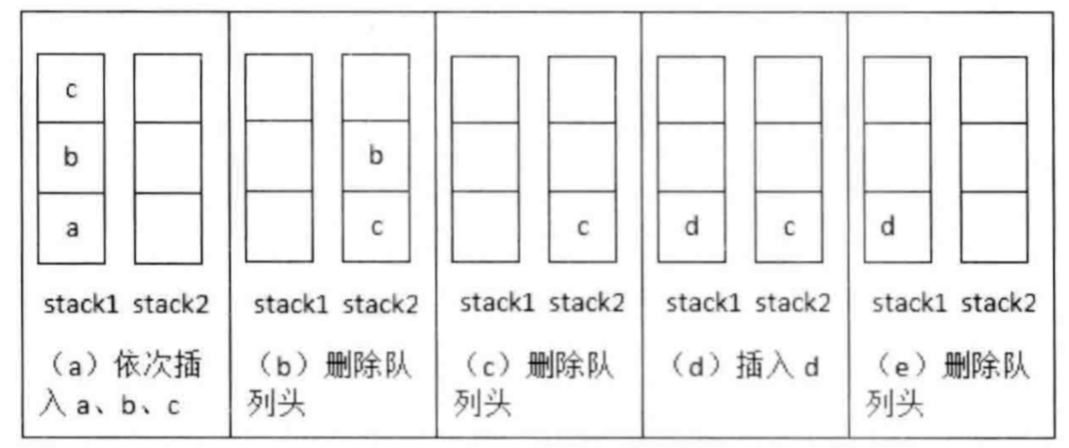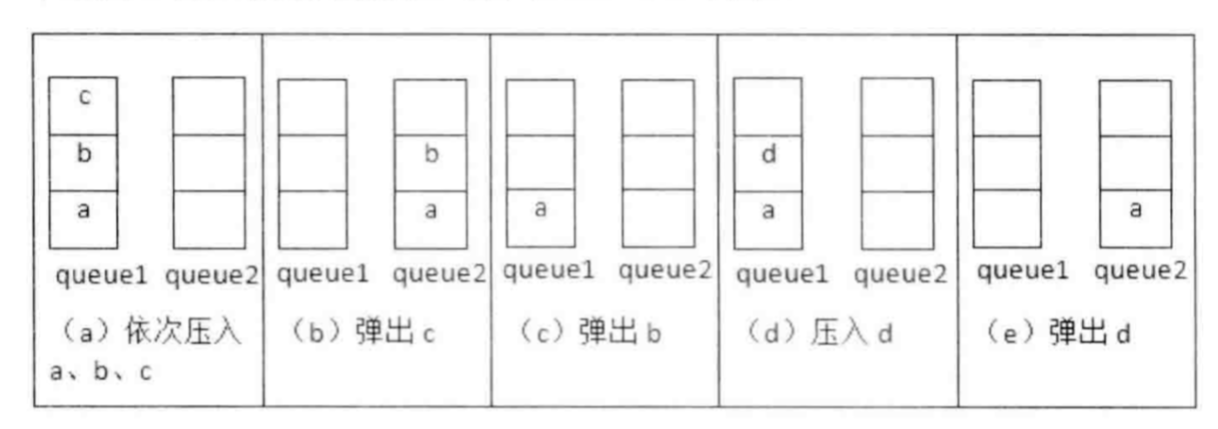题目描述:
用两个栈来实现一个队列,完成队列的Push和Pop操作。 队列中的元素为int类型。
解题思路:
本题的基本意图是:用两个后入先出的栈来实现先入先出的队列。对于这个问题,我们可以通过一个实例来进行具体分析。不难得出相应的规律:有两个栈stack1和stack2,每次向队列中插入元素可以都压入到stack1中,当需要从队列中删除元素时,我们应该是删除最早插入的那个(FIFO),这时可以将stack1中的元素逐个弹出并压入stack2,直到stack1为空,这时最早插入的元素就位于stack2的栈顶,可以直接弹出。
因此,我们总结如下:压入元素时,都压入栈1,当需要弹出时,从栈2弹出,当栈2不为空时直接弹出栈顶元素,为空时将栈1的元素“倒进去”。
举例:

编程实现(Java):
public class Solution {
Stack<Integer> stack1 = new Stack<Integer>();
Stack<Integer> stack2 = new Stack<Integer>();
public void push(int node) {
stack1.push(node);
}
public int pop() {
if(stack2.empty()){ //为空时将栈1的元素“倒进去”
while(!stack1.empty()){
stack2.push(stack1.pop());
}
}
return stack2.pop();
}
}
扩展:用两个队列实现一个栈
用两个队列实现栈相比稍微复杂,当插入一个元素时,可以选择不为空的那个队列直接加进去,而当删除一个元素时,需要借助另一个空队列,首先依次删除原队列的头,并将删除的元素加入另一个队列,直到找到队列最后一个元素,将其删除,这时原来的数据队列变空,另一个队列变为数据栈。

class MyStack {
Queue<Integer> q1,q2;
int topValue;
/** Initialize your data structure here. */
public MyStack() {
q1=new LinkedList<>();
q2=new LinkedList<>();
topValue=0;
}
/** Push element x onto stack. */
public void push(int x) { //压入到不为空的那个队列中
if(!q1.isEmpty())
q1.add(x);
else
q2.add(x);
topValue=x;
}
/** Removes the element on top of the stack and returns that element. */
public int pop() {
int temp=0;
while(!q1.isEmpty()){ //q1不空
temp=q1.poll();
if(q1.isEmpty())
return temp;
q2.add(temp);
topValue=temp;
}
while(!q2.isEmpty()){ //q1不空
temp=q2.poll();
if(!q2.isEmpty()){
q1.add(temp);
topValue=temp;
}
}
return temp;
}
/** Get the top element. */
public int top() {
return topValue;
}
/** Returns whether the stack is empty. */
public boolean empty() {
return q1.isEmpty() && q2.isEmpty();
}
}